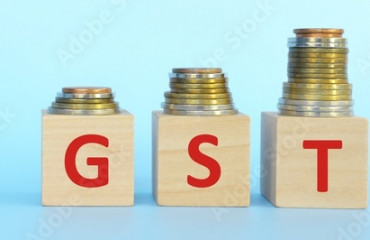
Globally, one of the widely tracked economic metrics is the tax-to-GDP ratio. Taxes comprise direct and indirect taxes. In India, the Centre’s gross tax revenue-to-GDP has increased and the share of indirect taxes in tax collections has decreased over the last decade.
Globally, one of the widely tracked economic metrics is the tax-to-GDP ratio. Taxes comprise direct and indirect taxes. In India, the Centre's gross tax revenue-to-GDP has increased and the share of indirect taxes in tax collections has decreased over the last decade.
Indirect taxes contribute more than 40% to the Centre's tax kitty and the goods and services tax (GST) has a dominant share of it. GST, one of the biggest structural reforms since Independence introduced by the Modi Government in its first term, has completed seven years since its rollout in July 2017.
India was transformed into a 'one nation-one tax-one market' with the introduction of GST, which subsumed 30 taxes. It improved India's ease of doing business ranking and fostered formalization. Indirect taxes, in general, are considered regressive as they apply at the rate rate to purchases by the rich and poor.
However, an element of progressivity has been added in GST by way of multiple rate slabs, with higher incidence on products consumed by affluent classes and zero or low rates of tax on mass consumption items.
Also read: Focus on real tax evasion, not issues prone to interpretation, tax officials told
In the post-GST regime, the Indian economy witnessed a series of shocks, even though average inflation trended lower, and the revenue-neutral rate fell relative to the rate estimated at the time of its launch.
Despite these events, GST revenues, excluding 2017-18 when GST was applicable for only 9 months, grew 11.4% annually from 2018-19 to 2023-24 while nominal GDP grew at 9.3%, implying GST buoyancy of 1.22.
The way economic growth is driven by an accumulation of capital stock, an increase in labour inputs and technological advancement, a surge in GST revenues is driven by economic growth and concomitant performance of labour markets, expansion of the GST net, enhanced compliance and the detection of evasion and bogus registrations.
First, despite the shocks to the Indian economy, labour market indicators—the labour force participation rate, worker population ratio, unemployment rate, absolute employment numbers and growth in average earnings in rural as well as urban segments—have shown superior performance from 2018-19 to 2022-23 (last available data). According to the latest RBI KLEMS database, labour's income share has increased for the period 2018-19 to 2023-24.
Since GST is a consumption-based tax, the surge in its revenues would be captured in consumption data. Also, since income is either spent or saved, improved labour market indicators and increased labour income share have been reflected in private final consumption expenditure data, whose share in nominal GDP increased from 59.3% in 2018-19 to 60.3% in 2023-24. The increase is validated in general sense.
The growth is also possible due to different growth rates in items of consumption, especially higher growth in the consumption of high-value items (mostly in the top GST bracket).
Also read: Government steps up fight against fake GST registrations
The disaggregated data (available until 2022-23) of private final consumption expenditure and gross fixed capital formation (GFCF) reveals varying growth.
The share of health, communication, insurance and financial services (other than insurance) and transport (including purchase of vehicles) in private final consumption expenditure increased from 2018-19 to 2022-23. The share of the household sector's dwellings, other buildings and structures in GFCF also increased.
This consumption pattern is supported by growth in incomes, along with higher incomes for the self-employed and salaried categories. Data on income tax return filings reflect this.
While the number of income tax filings increased from 67 million in 2018-19 to 78 million in 2022-23, the share of zero-tax liability returns in this decreased from 73.5% to 64% and the weighted mean annual income of taxpayers increased from ₹10.4 lakh to ₹13 lakh. This trend would have likely continued in assessment year 2024-25.
As for GST, the GST Council's decision in August 2023 that online gaming companies will have to pay 28% GST, up from 18%, led to a jump in revenues.
The number of GST returns filed has increased from 162.3 million in 2018-19 to 223 million in 2023-24, thanks to invoice matching, generation of e-way bills and e-invoicing.
In the last five years, more than ₹4.45 trillion worth of GST evasion was detected and more than ₹1.05 trillion was recovered. More than 18 million addresses of registered businesses have been geo-coded to check bogus registrations.
Sustaining the growth in GST revenues is primarily dependent on the consumption growth momentum, which can be realized if the Indian economy stays resilient, delivers robust growth (of 7%-plus) and sees increases in the worker population ratio through the generation of earning opportunities.
The Indian economy must progress towards realizing Engel elasticity, which is a measure of the sensitivity of demand to a change in income. The generation of additional income-earning opportunities to lift the worker population ratio isn't sufficient; opportunities must be created in more productive manufacturing and services sectors.
Also read: Small businesses still outside the formal structure? There exist challenges.
Additionally, the focus of the Modi government must remain on improving the ease of doing business and generating formal jobs. Addressing high youth unemployment, as attempted in Union Budget 2024, would also provide a fillip to consumption.
Rate rationalisation and the inclusion of excluded commodities like petroleum products in GST are other policy actions that can spur consumption.
According to the International Monetary Fund, an additional 1.5% of GDP can be raised by the rationalization and simplification of GST rates.
Finally, enhanced compliance and reduced litigation can also prop GST revenues.
Sandeep Vempati is an economist and member of the Bharatiya Janata Party.
